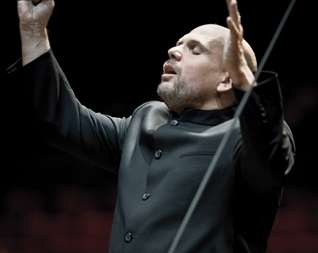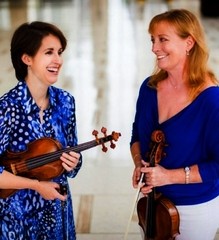|
Back
Grief Without End New York
Avery Fisher Hall, Lincoln Center
11/20/2014 - & November 21, 22*, 2014
Wolfgang Amadeus Mozart: Sinfonia Concertante for Violin and Viola, K. 320d [364]
Dmitri Shostakovich: Symphony No. 8 in C Minor, Opus 65
Sheryl Staples (Violin), Cynthia Phelps (Viola)
New York Philharmonic Orchestra, Jaap van Zweden (Conductor)

J. van Zweden (© Hans van der Woerd)
What a unique challenge we had this week! Two of the more enigmatic (and longest) symphonies of the 20th Century, played within 72 hours of each other. Forgetting the lengths (they were of heavenly or hellish duration), but the puzzles within them were enough to exercise–or ex-or-cize–the inner demons and angels of any listener.
That is, any listener who heard Michael Tilson Thomas’s Mahler Seventh Symphony and Jaap van Zweden’s Shostakovich Eighth Symphony.
If one had to choose an essential difference in their attitudes to musical aspirations, one might say that Mahler, living in peace between the French-Prussian War and the First World War, wrote about the demons and angels mind, his spirits in combat with the metaphysical/religious spirits of his inner soul.
Dmitri Shostakovich had his political demons cut out for him. Stalin and Stalingrad, the idiocies of Communist power, and the arrogance of physical censorship.
Mahler was wrapped in the earth and the heavens, Shostakovich in the wormy earth and its man-made ordures.
Whatever one’s personal preferences, hearing them both, played by two great orchestras (San Francisco and New York) was a singular experience.
I had never heard conductor Jaap van Zweden before, but his resume was a most impressive one. At present, he has two orchestras, one in Dallas, and the other in my old home, Hong Kong, where, after Edo de Waart, he is the second Dutch conductor to lead the group. Nor do I know whether the Hong Kong experience has prompted him to be especially animated, especially careful in judiciously cueing in the orchestra.
With the New York Philharmonic, Mr. van Zweden had to use all that intensity. If a single measure sags in the Eighth Symphony, any conductor can be defeated. For this is another “war” symphony, and a work where Shostakovich never assuaged his official pursuers by giving way to “glorious victory.”
The opening movement (which takes half the hour-long work) is unceasingly grim, the drums and trumpets and opening cello lines desolate. Yet under Mr. van Zweden’s animated baton, that desolation became almost arrogant, a series of thrusts and impacts. They were not sudden, but they built up to climaxes, went down again and then proceeded to rise up again like a tank rolling over a body, then turning around and rolling over again.
The next two movements were Shostakovich as his most aggressive, most mordant, again kicking without stop, the dissonances, the shrieks without ending. Yet the most moving part of this work, as played here, as the slow movement, a passacaglia where the Philharmonic strings were at their purest, where the ending winds and brass played a coda to the preceding music.
That finale is the most enigmatic part of all. A more ordinary conductor might think that the harsh part is finished, he or she can end with a bit of tranquility. Mr. van Zweden knew that this was a Shostakovich who never intended to disguise sorrow with that Fifth Symphony crowd-pleasing grandeur. The solace was a disguise, and he pulled it out as far as it could go, tricking us until one of the grand grand surprises of Shostakovich: the return of the fortissimo brass of the nightmarish theme from the opening movement.
This was not a “moving” performance. Rather, it was objective, aloof, frightening, as if Mr. van Zweden felt he had no right to interfere in the severity of the composer’s grief.

S. Staples, C. Phelps (© New York Philharmonic)
Nothing could contrast more with the Eighth than Mozart’s opening Sinfonia Concertante, played by the Acting Concertmaster, Sheryl Staples and First Viola Cynthia Phelps.
I had heard Ms. Phelps perform the same work with Glenn Dicterow, the legendary Concertmaster who left the Phil only last year. It was a very different performance, for Mr. Dicterow had performed this with a sweep, an almost Romantic easiness showing the full joy of the work.
Ms. Staples was more careful, more classical, prudent, delightful in her colors, her confidence and above all, in her partnership with Ms. Phelps. The violist herself, ignored Mozart’s command to tune the viola a semitone higher probably to give a greater intensity to the playing.
But those were 18th Century violas, and Ms. Phelps gave her always stunning powerful performance, another assurance that this “concerto” was far more preferable to the Walton and Bartók “solo concerti”.
One problem was in the balance. Perhaps Mr. van Zweden is used to the horrible acoustics in the Hong Kong concert hall, for he built the Phil up so loudly that, at least in the first movement, they overcame the soloist. The final two movements, though, gave us a chance to hear these two fiddlers playing with utter delight, utmost artistry.
Harry Rolnick
|